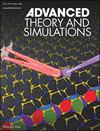是否可以通过加入中性或阴离子分子来实现无铅卤化物钙钛矿?
IF 2.9
4区 工程技术
Q1 MULTIDISCIPLINARY SCIENCES
引用次数: 0
摘要
探索无铅钙钛矿替代品是当前光伏领域的主要挑战。用无毒阳离子直接取代Pb通常会降低结构或电子尺寸,从而影响卤化物钙钛矿优异的光伏性能。在这项工作中,通过在钙钛矿晶格的a位上加入阴离子或中性分子来构建无铅卤化物钙钛矿,并通过第一性原理计算来评估光伏电势。预测无铅钙钛矿CH4BiCl3在光伏应用的最佳范围内具有直接带隙。由于b位Bi3+和Pb2+阳离子的电子构型相同,CH4BiCl3表现出与pb基卤化物钙钛矿相似的电子能带结构。计算得到的有效质量和电子和空穴的激子结合能表明CH4BiCl3光生载流子具有较高的迁移率。通过计算光谱极限最大效率证明了优异的光伏性能,在典型厚度为0.5µm时,效率为30.9%。通过计算分解能和从头算分子动力学模拟进一步评价了立方钙钛矿CH4BiCl3的结构稳定性,证明了CH4BiCl3在室温下的热力学稳定性。这些结果对探索新型无铅钙钛矿材料具有重要的指导意义。本文章由计算机程序翻译,如有差异,请以英文原文为准。

Can Pb-Free Halide Perovskites be Realized by Incorporating the Neutral or Anionic Molecule?
Exploring Pb-free perovskite alternatives is a major challenge in the current photovoltaic field. Direct substitution of Pb with a non-toxic cation usually lowers the structural or electronic dimension, thereby impacting the excellent photovoltaic properties of halide perovskites. In this work, Pb-free halide perovskites by incorporating the anionic or neutral molecules on the A-site of the perovskite lattice and assess the photovoltaic potential by first-principles calculations is constructed. The Pb-free perovskite CH4BiCl3 is predicted to have a direct bandgap within the optimal range for photovoltaic application. Due to the same electronic configuration of B-site Bi3+ and Pb2+ cations, the CH4BiCl3 exhibits a similar electronic band structure with Pb-based halide perovskites. The calculated effective masses and exciton binding energy of electron and hole indicate the high mobility of photogenerated carriers of CH4BiCl3. The excellent photovoltaic performance is demonstrated by calculating the spectroscopic limited maximum efficiency, which shows an efficiency of 30.9% for a typical thickness of 0.5 µm. The structural stability of cubic perovskite CH4BiCl3 is further evaluated by computing the decomposition energy and ab initio molecular dynamics simulation, demonstrating the thermodynamic stability of CH4BiCl3 at room temperature. These results can be a useful guide for exploring novel Pb-free perovskite materials.
求助全文
通过发布文献求助,成功后即可免费获取论文全文。
去求助
来源期刊

Advanced Theory and Simulations
Multidisciplinary-Multidisciplinary
CiteScore
5.50
自引率
3.00%
发文量
221
期刊介绍:
Advanced Theory and Simulations is an interdisciplinary, international, English-language journal that publishes high-quality scientific results focusing on the development and application of theoretical methods, modeling and simulation approaches in all natural science and medicine areas, including:
materials, chemistry, condensed matter physics
engineering, energy
life science, biology, medicine
atmospheric/environmental science, climate science
planetary science, astronomy, cosmology
method development, numerical methods, statistics
 求助内容:
求助内容: 应助结果提醒方式:
应助结果提醒方式:


